Dorado, dolphin and mahi-mahi are all the same fish, and are here year round with November, December, January, being the best months. If you want to have a shot at the biggest dorado, come fish Costa Rica during June and July and you will have your best shot. And who wouldn’t want a shot, seeing that mahi-mahi is served around the world and is one of the best tasting fish out there. They are a very distinct looking fish, with bright yellow, green, and blue colors below its elongated dorsal fin. When underwater, its colors reflect the light and create an amazing glow off the fish. The world record dorado caught is 88 pounds, but more commonly they can be found in the three feet 40 pound range when travelling in schools.
Dorado Fishing
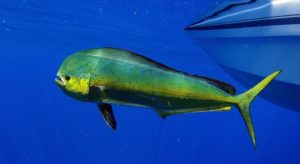
Dorado live very short lives, 5 years on average, but have some of the fastest growth rates for fish in the world. They have a very diverse diet, feeding on squid, crabs, smaller fish, and other smaller invertebrates. They are often founds on the surface, sometimes clustered under floating debris or seaweed patches. A lot of captains in Costa Rica will hook up on dolphin while going after sail fish or marlin. They are typically caught while trolling lures or ballyhoo, but can also be found when casting towards piles of debris or seaweed. Catch them on fly or conventional tackle; hook up on one with light tackle and be ready for the fight of a lifetime. Catch a few dorado and bring some in, we will find you a place to cook em’ up!
A blue marlin is the most common of your marlins here as they cruise the Costa Rica waters year round, and most readily found in October, November, December although the last few years we have encountered a great number of them year round. Blue marlin are one of the most prized fish to be caught in all of Costa Rica, and arguably all of the world. Their strength and beauty is unmatched, growing up to 14 feet and weighing nearly 2,000 pounds. They are among the fastest and most aggressive fish in the open ocean, making for a great fight for any fisherman daring enough to challenge them. They are a very migratory fish, travelling thousands of miles as they cruise through the blue water. The average blue weights in at about 300 pounds, a monstrous fish by anyone’s standards. Blue marlin live in the Atlantic, Pacific, and Indian Ocean, with their highest concentrations being off the coast of Central America.
Blue Marlin Fishing
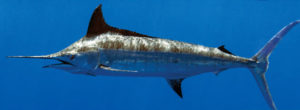
In Costa Rica, the best areas for blue marlin fishing are the Central Pacific area (Los Suenos and Quepos fishing grounds are the most popular) or the Southern Pacific (Golfito, Drake Bay). Most are found swimming above natural humps and shelfs that form on the ocean floor, which cause currents and create concentrations of bait. Marlin feed primarily on species of tuna and other smaller preferably live bait like mackerel and squid, as well as lures. Marlin will often use their spear-like bill and attempt to wound a school of baitfish, then sweep back to chomp down their wounded victims.
Nothing beats the thrill of watching a 600 lb. marlin track and gulp down your fly, something that I have been lucky enough to experience a few times. It is illegal to keep and eat marlin here in Costa Rica, a great protective measure that is successfully preserving such a beautiful species. If you have ever read Hemingway’s classic The Old Man In the Sea, you should know that the fish the old man desperately battles is in fact a blue marlin. Maybe you will get the chance to hook up on a fish like that on your next Costa Rica fishing trip; let’s just hope you don’t fight it for days and that the sharks don’t get to it!

Black Marling Fishing
The black marlin are most abundant in Costa Rica in June, July, and August, although like their cousin the blue marlin, we have been seeing more and more year round. Black marlin fishing is also best around the Central and Southern Pacific areas of Costa Rica. They too will feed on tuna, squid, mackerel, and ballyhoo, as well as artificial lures like a Rapala or imitation squid. In terms of flies, they will crush poppers or streamers with a ferocity unmatched by any other fish species. The world record black marlin caught was nearly 1,600 pounds. With an average weight of around 200 lbs, they truly are a magnificent sight cruising above the shelves looking for prey. Like the blue, black marlin in Costa Rica are great fighting fish, and they are able to reach speeds of up to 65 mph. Whether it be a black or blue marlin, Costa Rican waters will always provide you with the opportunity to catch one of these beasts of the sea.
Striped marlin are generally smaller and not as sought after as black and blues, but hooking up on a striped marlin while fishing in Costa Rica is still a thrill. They are easily identified by their beautiful light blue vertical stripes along their body, which makes them just as beautiful, if not more, than their cousins. “Stripeys” are caught year round here, and are also found primarily around the Quepos and Golfito area. Striped marlin are found from Oregon down to South America, but are most highly concentrated around Costa Rica during the winter months. They are the most migratory of all the marlin species, and have been known to swim as much as 31 miles per day. Striped marlin are generally a solitary species, but will also be found travelling in pairs or in schools.
Striped Marling Fishing
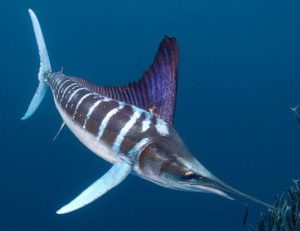
When swimming, they will be spending the majority of the time swimming and feeding near the surface, which means birds can be used as a great identifier to finding large schools of stripeys. When caught, they are often more acrobatic than other marlin species because of the fact that they are lighter and more aerodynamic. A fight with a striped marlin will more often than not include some incredible leaps. The world record striped marlin caught was over 13.5 feet and weighed nearly 500 pounds, but the average striped marlin caught in Costa Rica weighs in at right around 140 pounds. These fish are often caught on lures, flies, and live bait, but are also more likely to feed on shrimp and crabs than their other marlin counterparts. While hooking up on some blues, sailfish, and rooster, why not mix in a fun fight with a stripey.
Sails are here year round, with the peak time coming from January through July. In Costa Rica, it is not uncommon to raise 10-20 sailfish to the boat in a given day, with a good day seeing 30+. As for the rest of the year, it is very common to raise 3-8 per day. Although not as large or powerful as marlin, sailfish offer a more consistent bite and are easier to find. They are not as protected as the marlin species because their population has remained stable, and great numbers of sailfish are always here in Costa Rica. A day of hooking sailfish after sailfish on the fly or on conventional tackle will wear you down, but will leave you with a huge grin on your face and your heart racing quicker than usual. Larger sailfish are around 10 ft in length and weigh close to 200 lbs.
Sailfish Fishing
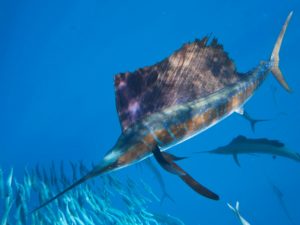
Like the striped marlin, sailfish are leapers. They also have the amazing ability to change colors when they are hunting, using iridescent dots to confuse their prey and signal to other sailfish. They often will use their “sails” to herd schools of food, which include anchovies, sardines, squid, and octopus. You will primarily find sailfish a handful of miles offshore, feeding on schools of bait fish near the surface, perhaps swimming under groups of hungry birds. Sailfish are great for those looking to fly fish here in Costa Rica, with their abundance making for lots of action. They in fact are the fastest fish in the ocean, reaching speeds of up to 68 mph. Their jumping ability combined with this speed makes for one heck of a fight, let’s just hope they don’t win!
Yellowfin tuna is the main tuna species and for sure are the big boys in Costa Rica. These 100-300 pound fish will test your back, your legs, your everything. The world record tuna was over 400 pounds, but you were usually find that most tuna are smaller and travel in large schools. You find the porpoises and you have generally found the tuna. The big tuna swim with the dolphin and feed on the same bait fish. Also, as the smaller tuna school up for the bait, you will find the marlin and sailfish schooling up right along with them. Many times we will hook a smaller tuna and throw it out there, waiting for that big marlin to attack.
Yellowfin Tuna Sport Fishing
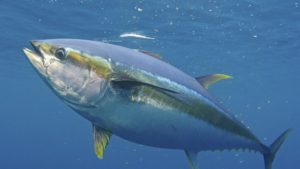
So enjoy the fight on lighter gear with the tuna, then hang on for a wild ride against the marlin. In Costa Rica, tuna are found throughout the year, with the best months for yellowfin being June through September. The best areas for tuna are Quepos and Los Suenos, but they are also found up and down the Pacific coast. Like dorado, yellowfins also provide a great fight and, after being caught, can be served for an amazing dinner while watching the Costa Rica sunset. With the chance to catch yellowfin, mahi mahi, sailfish, and marlin all on the same trip, who wouldn’t want to come fishing in Costa Rica!?
Wahoo are rare in these waters but we do catch a few. Generally we hook up on 2-4 per year that are in the 50-100 pound range. Slender and elongated bodies allow wahoo to cruise through the water while seeking out food. They can reach up to eight feet in length and 180 pounds in length and are somewhat similar in appearance to a barracuda or mackerel. Just like the barracuda, they have razor sharp teeth and will bite right through your line if you aren’t using steel leaders.
Wahoo Sport Fishing
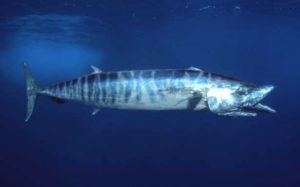
They are also good tasting fish, but are harder to come by because of their tendency to travel individually. They are found while fishing for marlin or sailfish, and will feed primarily on smaller fish and squid. Catch them trolling or with live bait and you won’t be disappointed. Don’t plan your Costa Rica fishing trip around catching one of these fish, but if you do, you will most likely be screaming WAHOO the entire time you’re fighting these fish.

Roosterfish Sport Fishing
The most targeted in shore fish is available in good numbers year around here in COSTA RICAN water’s. They will average 20-50 lbs. and can run as large as 100lb’s or more. They are caught in Costa Rica throughout the year, and never disappoint anglers with their power and unique beauty. Hooking up with one of these monsters is incredible, as they bend your rod with brute strength and try to pull you down to the bottom ocean with them. A cousin of the jack, roosterfish are primarily found inshore near rock piles, but can also be found near river mouths as well as near the surf. I have never found a place better than here in the southern end of COSTA RICA for roosterfishing. Roosters, or “gallos” in Spanish, are mostly caught with live baits like mullet or blue runners, and can also be caught on the fly. The gulf of Dulce Bay is just loaded with sardines and blue runners, the best bait for roosters. We have had many clients out after a big one and every time they have come home with big smiles.
We have here in COSTA RICA dozens of different species of snapper from 3 pounders all the way up to 50+ pounders. The Cubera snapper is the most common along with the dog snapper, mullet snapper, spotted rose snapper, and many more. Cuberas are found near rock piles in around 150 feet of water, and range from 20-75 lbs, The world record snapper was 121 pounds, caught on live bait. Snapper make for very fun action on light weight tackle, especially as they jerk their head back and forth and head to the bottom of the ocean.
Snapper Fishing
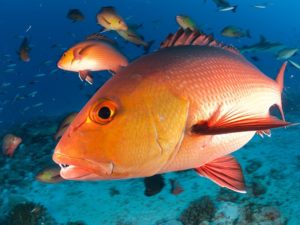
Red snapper run a lot smaller, with the world record being 50 pounds and the average being around one-foot in length, but are among the most delicious of fish here. The best part of catching snapper; enjoying them for dinner. Snappers can be caught fishing from the beach, near mangroves, in the Pacific, in the Atlantic, basically all over Costa Rica. The biggest snapper are brought up from the bottom of the ocean, and can primarily be caught jigging or while trolling. They will eat almost anything that is put in front of them as they are very aggressive and territorial. While jigging for snapper, don’t be surprised if you pull up a mighty grouper.
The next two fish we mention, snook and tarpon, are caught mainly on the Caribbean side of Costa Rica, but snook can also be found on the Pacific side near river mouths, mangroves and in the surf. Snook will be found in both fresh and salt water, sometimes travelling far up fresh water rivers, only to return to the ocean. This behavior and breeding habits creates a similarity between them and striped bass. Snook are also a great eat when caught, rivaling dorado and snapper with their tastiness. Caribbean snook, as the name states, are found on the Caribbean side, and are the largest and most sought after snook in Costa Rica.
Snook Fishing
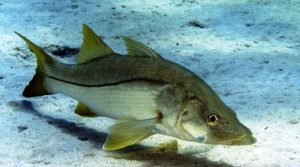
The record for this type of snook is over 50 lbs and was caught in Costa Rica, while many 40 pounders are caught every year. Most of the snook fishing in Costa Rica is done from the shore, throwing soft plastic jigs and light-weight tackle. There are 7 other different varieties of snook here in Costa Rica, many of which are found on the Pacific side as well. Snook are warm water fish, and are extremely affected by temperature changes. This is just one of the reasons why they are so finicky, making them a challenge to catch. Come to the Pacific or the Caribbean side of Costa Rica and take your shot at some delicious snook.
Tarpon fishing in Costa Rica is only done on the Caribbean side of Costa Rica, but the adventure and bite are worth the trip down here by themselves. Most tarpon fishing trips we send people to originate in Tortuguero, where you will cruise through the canals in search of these monsters. Tarpon can also be caught in the surf and out on the open ocean all along the Atlantic coast of Costa Rica. Tarpon are often caught on live crabs and baitfish, while a variety of lures and flies work as well.
Tarpon Fishing

Tarpon are incredible looking creatures, almost prehistoric-like, and can grow up to 8 feet and nearly 300 pounds. You probably won’t see a picture of a tarpon in which the fishing isn’t jumping; tarpon are known to put up one heck of a fight. Although Florida is famous for its tarpon fishing, Costa Rica offers an opportunity to catch more and bigger tarpon. These “silver kings” are most likely to be caught here from May to October, although they are around all year. Come down and marvel at the acrobatic spins and jumps that these fish are capable of making and you’ll be jumping for joy as well.
